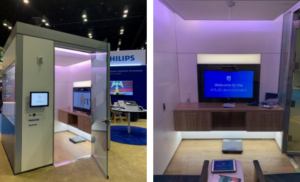
A demonstration was available at the 120th Veterans of Foreign Wars (VFW) National Convention in Orlando, Florida, held July 20–24, 2019. Source: VA
WASHINGTON, DC — A recent report is calling into question the effectiveness of VA’s ATLAS program, a pilot telehealth initiative that places telehealth booths at non-VA community spaces in rural areas where veterans are more likely not to have access to high-speed internet. Veterans can use the booths to conduct telehealth appointments with VA providers.
A Government Accountability Office (GAO) report has found, however, that, in 2022 and 2023, 14 of the 24 active sites went entirely unused.
While the program launched in 2019 as a way to bridge the gap between rural veterans and VA care, it was the COVID-19 pandemic that shone a spotlight on the program, which VA featured heavily when discussing their full array of telehealth initiatives. The 24 booths were installed inside Walmart stores, universities, American Legion sites, libraries and other private locations with high-speed internet that were considered easily accessible and familiar to veterans.
As of April 2024, the Office of Connected Care has deactivated one site and, due to lack of use, is requesting the deactivation of six more, five of them located inside Walmarts, which offered only four available appointment times each week.
While many of the sites went unused, those that did receive visitors provided a valuable service to rural veterans, local officials told GAO investigators.
“Officials from [a] medical center located in a rural area that oversees an ATLAS site told us that one benefit of ATLAS has been reducing travel time to receive care, especially during the winter, when driving may be more difficult,” the report states. “For example, one veteran was able to have a telehealth visit with a VHA provider at an ATLAS site and get a prescription on the same day during the winter when local providers were not available for an in-person visit.”
Attendants stationed at the ATLAS sites also have assisted veterans with “limited digital literacy” in navigating how to begin their telehealth experience.
But while these anecdotal reports suggest the program can have a positive impact on rural veterans, the full extent and details of that impact are unknown due to a lack of oversight by VA.
“Office of Connected Care officials have taken important steps to gather program information, but they have not developed national-level performance goals and related measures that would allow them to assess the effectiveness of the ATLAS program on an ongoing basis,” the GAO report notes. “Rather, Office of Connected Care officials told us that VA medical centers are primarily responsible for developing performance measures individualized to their sites and geographic needs to help assess their effectiveness.”
VAMCs are asked to complete self-assessment forms for their sites, including any challenges they’re facing getting veterans to use the booths. But VA officials told GAO that the assessments are not used to assess the effectiveness of the ATLAS sites nationally.
With much of the responsibility left to individual medical centers, efforts to evaluate sites’ success has varied widely.
“Officials from the two medical centers we spoke with that had ATLAS sites told us they had not developed performance measures for their sites,” the GAO investigators wrote. “Officials from one of these medical centers stated that the facility does not have site-specific metrics in place to formally monitor visits or veteran satisfaction, in part due to the low number of visits the site has had to date. … In addition, a representative from the veterans service organization that hosts of one of these sites noted that the medical center did not have any site-specific metrics or processes to evaluate success.”
According to GAO, VA has established processes to centrally monitor the effectiveness of its broader array of telehealth services and should do the same with the ATLAS initiative.
“For example, the Office of Connected Care could set goals and related measures to help monitor and address low ATLAS site usage. Because the office already tracks the number of visits at each site, a goal could be to increase video telehealth usage by veterans at those sites over a 5-year period,” the report suggested. “A related measure could then be a targeted percent increase in completed visits per ATLAS site. [Another] could involve tracking promotional strategies and awareness campaigns to determine how many veterans are reached.”
In the meantime, VA is shifting ATLAS from a pilot program to a grant program, which may result in the opening of new sites. It’s also instituted a new policy requiring medical centers requesting a site to perform a market analysis to determine needs and community demand, in the hopes of preventing another year where sites lie vacant.

